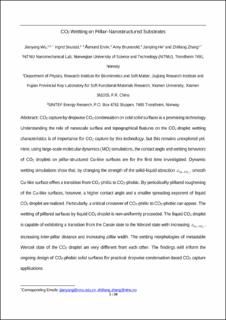CO2 Wetting on Pillar-Nanostructured Substrates
Peer reviewed, Journal article
Accepted version

Åpne
Permanent lenke
https://hdl.handle.net/11250/2651619Utgivelsesdato
2020Metadata
Vis full innførselSamlinger
Originalversjon
10.1088/1361-6528/ab7c49Sammendrag
CO2 capture by dropwise CO2 condensation on cold solid surfaces is a promising technology. Understanding the role of the nanoscale surface and topographical features of CO2 droplet wetting characteristics is of importance for CO2 capture by this technology, but this remains unexplored as of yet. Here, using large-scale molecular dynamics (MD) simulations, the contact angle and wetting behaviors of CO2 droplets on pillar-structured Cu-like surfaces are investigated for the first time. Dynamic wetting simulations show that, by changing the strength of the solid–liquid attraction ${\varepsilon }_{{\rm{Cu}}-{{\rm{CO}}}_{{\rm{2}}}},$ a smooth Cu-like surface offers a transition from CO2-philic to CO2-phobic. By periodically pillared roughening of the Cu-like surfaces, however, a higher contact angle and a smaller spreading exponent of a liquid CO2 droplet are realized. Particularly, a critical crossover of CO2-philic to CO2-phobic can appear. The wetting of the pillared surfaces by a liquid CO2 droplet proceeds non-uniformly. A liquid CO2 droplet is capable of exhibiting a transition from the Cassie state to the Wenzel state with increasing ${\varepsilon }_{{\rm{Cu}}-{{\rm{CO}}}_{{\rm{2}}}},$ increasing inter-pillar distance, and increasing pillar width. The wetting morphologies of the metastable Wenzel state of a CO2 droplet are very different from each other. The findings will inform the ongoing design of CO2-phobic solid surfaces for practical dropwise condensation-based CO2 capture applications.